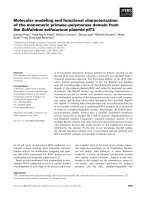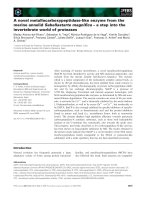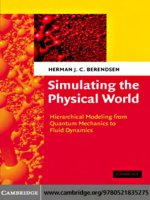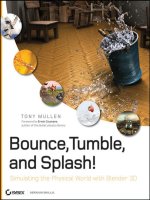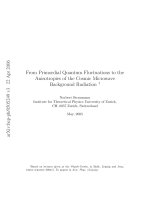- Trang chủ >>
- Khoa Học Tự Nhiên >>
- Vật lý
Simulating the physical world; hierarchical modeling from quantum mechanics to fluid dynamics
Bạn đang xem bản rút gọn của tài liệu. Xem và tải ngay bản đầy đủ của tài liệu tại đây (3.75 MB, 626 trang )
This page intentionally left blank
www.pdfgrip.com
SIMULATING THE PHYSICAL WORLD
The simulation of physical systems requires a simplified, hierarchical approach,
which models each level from the atomistic to the macroscopic scale. From quantum mechanics to fluid dynamics, this book systematically treats the broad scope
of computer modeling and simulations, describing the fundamental theory behind
each level of approximation. Berendsen evaluates each stage in relation to their
applications giving the reader insight into the possibilities and limitations of the
models. Practical guidance for applications and sample programs in Python are
provided. With a strong emphasis on molecular models in chemistry and biochemistry, this book will be suitable for advanced undergraduate and graduate courses
on molecular modeling and simulation within physics, biophysics, physical chemistry and materials science. It will also be a useful reference to all those working in
the field. Additional resources for this title including solutions for instructors and
programs are available online at www.cambridge.org/9780521835275.
H e r m a n J . C . B e r e n d s e n is Emeritus Professor of Physical Chemistry at
the University of Groningen. His research focuses on biomolecular modeling and
computer simulations of complex systems. He has taught hierarchical modeling
worldwide and is highly regarded in this field.
www.pdfgrip.com
www.pdfgrip.com
SIMULATING THE PHYSICAL WORLD
Hierarchical Modeling from Quantum
Mechanics to Fluid Dynamics
HERMAN J. C. BERENDSEN
Emeritus Professor of Physical Chemistry,
University of Groningen, the Netherlands
www.pdfgrip.com
CAMBRIDGE UNIVERSITY PRESS
Cambridge, New York, Melbourne, Madrid, Cape Town, Singapore, São Paulo
Cambridge University Press
The Edinburgh Building, Cambridge CB2 8RU, UK
Published in the United States of America by Cambridge University Press, New York
www.cambridge.org
Information on this title: www.cambridge.org/9780521835275
© H. J. C. Berendsen 2007
This publication is in copyright. Subject to statutory exception and to the provision of
relevant collective licensing agreements, no reproduction of any part may take place
without the written permission of Cambridge University Press.
First published in print format 2007
eBook (EBL)
ISBN-13 978-0-511-29491-4
ISBN-10 0-511-29491-3
eBook (EBL)
hardback
ISBN-13 978-0-521-83527-5
hardback
ISBN-10 0-521-83527-5
paperback
ISBN-13 978-0-521-54294-4
paperback
ISBN-10 0-521-54294-4
Cambridge University Press has no responsibility for the persistence or accuracy of urls
for external or third-party internet websites referred to in this publication, and does not
guarantee that any content on such websites is, or will remain, accurate or appropriate.
www.pdfgrip.com
Contents
Preface
Symbols, units and constants
Part I
page xi
xv
A Modeling Hierarchy for Simulations
1
1
Introduction
1.1 What is this book about?
1.2 A modeling hierarchy
1.3 Trajectories and distributions
1.4 Further reading
3
3
9
13
14
2
Quantum mechanics: principles and relativistic effects
2.1 The wave character of particles
2.2 Non-relativistic single free particle
2.3 Relativistic energy relations for a free particle
2.4 Electrodynamic interactions
2.5 Fermions, bosons and the parity rule
19
19
23
25
31
36
3
From quantum to classical mechanics: when and how
3.1 Introduction
3.2 From quantum to classical dynamics
3.3 Path integral quantum mechanics
3.4 Quantum hydrodynamics
3.5 Quantum corrections to classical behavior
39
39
42
44
64
70
4
Quantum chemistry: solving the time-independent Schră
odinger equation
77
4.1 Introduction
77
4.2 Stationary solutions of the TDSE
78
4.3 The few-particle problem
79
4.4 The Born–Oppenheimer approximation
97
v
www.pdfgrip.com
vi
Contents
4.5
4.6
4.7
4.8
4.9
4.10
The many-electron problem of quantum chemistry
Hartree–Fock methods
Density functional theory
Excited-state quantum mechanics
Approximate quantum methods
Nuclear quantum states
98
99
102
105
106
107
5
Dynamics of mixed quantum/classical systems
5.1 Introduction
5.2 Quantum dynamics in a non-stationary potential
5.3 Embedding in a classical environment
109
109
114
129
6
Molecular dynamics
6.1 Introduction
6.2 Boundary conditions of the system
6.3 Force field descriptions
6.4 Solving the equations of motion
6.5 Controlling the system
6.6 Replica exchange method
6.7 Applications of molecular dynamics
139
139
140
149
189
194
204
207
7
Free
7.1
7.2
7.3
7.4
7.5
7.6
7.7
7.8
211
211
213
218
221
227
231
234
239
8
Stochastic dynamics: reducing degrees of freedom
8.1 Distinguishing relevant degrees of freedom
8.2 The generalized Langevin equation
8.3 The potential of mean force
8.4 Superatom approach
8.5 The fluctuation–dissipation theorem
8.6 Langevin dynamics
8.7 Brownian dynamics
8.8 Probability distributions and Fokker–Planck equations
8.9 Smart Monte Carlo methods
8.10 How to obtain the friction tensor
energy, entropy and potential of mean force
Introduction
Free energy determination by spatial integration
Thermodynamic potentials and particle insertion
Free energy by perturbation and integration
Free energy and potentials of mean force
Reconstruction of free energy from PMF
Methods to derive the potential of mean force
Free energy from non-equilibrium processes
www.pdfgrip.com
249
249
251
255
256
257
263
268
269
272
274
Contents
vii
9
Coarse graining from particles to fluid dynamics
9.1 Introduction
9.2 The macroscopic equations of fluid dynamics
9.3 Coarse graining in space
9.4 Conclusion
279
279
281
288
295
10
Mesoscopic continuum dynamics
10.1 Introduction
10.2 Connection to irreversible thermodynamics
10.3 The mean field approach to the chemical potential
297
297
298
301
11
Dissipative particle dynamics
11.1 Representing continuum equations by particles
11.2 Prescribing fluid parameters
11.3 Numerical solutions
11.4 Applications
305
307
308
309
309
Part II
313
Physical and Theoretical Concepts
12
Fourier transforms
12.1 Definitions and properties
12.2 Convolution and autocorrelation
12.3 Operators
12.4 Uncertainty relations
12.5 Examples of functions and transforms
12.6 Discrete Fourier transforms
12.7 Fast Fourier transforms
12.8 Autocorrelation and spectral density from FFT
12.9 Multidimensional Fourier transforms
315
315
316
317
318
320
323
324
325
331
13
Electromagnetism
13.1 Maxwell’s equation for vacuum
13.2 Maxwell’s equation for polarizable matter
13.3 Integrated form of Maxwell’s equations
13.4 Potentials
13.5 Waves
13.6 Energies
13.7 Quasi-stationary electrostatics
13.8 Multipole expansion
13.9 Potentials and fields in non-periodic systems
13.10 Potentials and fields in periodic systems of charges
335
335
336
337
337
338
339
340
353
362
362
www.pdfgrip.com
viii
Contents
14
Vectors, operators and vector spaces
14.1 Introduction
14.2 Definitions
14.3 Hilbert spaces of wave functions
14.4 Operators in Hilbert space
14.5 Transformations of the basis set
14.6 Exponential operators and matrices
14.7 Equations of motion
14.8 The density matrix
379
379
380
381
382
384
385
390
392
15
Lagrangian and Hamiltonian mechanics
15.1 Introduction
15.2 Lagrangian mechanics
15.3 Hamiltonian mechanics
15.4 Cyclic coordinates
15.5 Coordinate transformations
15.6 Translation and rotation
15.7 Rigid body motion
15.8 Holonomic constraints
397
397
398
399
400
401
403
405
417
16
Review of thermodynamics
16.1 Introduction and history
16.2 Definitions
16.3 Thermodynamic equilibrium relations
16.4 The second law
16.5 Phase behavior
16.6 Activities and standard states
16.7 Reaction equilibria
16.8 Colligative properties
16.9 Tabulated thermodynamic quantities
16.10 Thermodynamics of irreversible processes
423
423
425
429
432
433
435
437
441
443
444
17
Review of statistical mechanics
17.1 Introduction
17.2 Ensembles and the postulates of statistical mechanics
17.3 Identification of thermodynamical variables
17.4 Other ensembles
17.5 Fermi–Dirac, Bose–Einstein and Boltzmann statistics
17.6 The classical approximation
17.7 Pressure and virial
17.8 Liouville equations in phase space
17.9 Canonical distribution functions
453
453
454
457
459
463
472
479
492
497
www.pdfgrip.com
Contents
18
ix
17.10 The generalized equipartition theorem
502
Linear response theory
18.1 Introduction
18.2 Linear response relations
18.3 Relation to time correlation functions
18.4 The Einstein relation
18.5 Non-equilibrium molecular dynamics
505
505
506
511
518
519
19
Splines for everything
19.1 Introduction
19.2 Cubic splines through points
19.3 Fitting splines
19.4 Fitting distribution functions
19.5 Splines for tabulation
19.6 Algorithms for spline interpolation
19.7 B-splines
References
Index
www.pdfgrip.com
523
523
526
530
536
539
542
548
557
587
www.pdfgrip.com
Preface
This book was conceived as a result of many years research with students
and postdocs in molecular simulation, and shaped over several courses on
the subject given at the University of Groningen, the Eidgenă
ossische Technische Hochschule (ETH) in Ză
urich, the University of Cambridge, UK, the
University of Rome (La Sapienza), and the University of North Carolina
at Chapel Hill, NC, USA. The leading theme has been the truly interdisciplinary character of molecular simulation: its gamma of methods and models
encompasses the sciences ranging from advanced theoretical physics to very
applied (bio)technology, and it attracts chemists and biologists with limited
mathematical training as well as physicists, computer scientists and mathematicians. There is a clear hierarchy in models used for simulations, ranging
from detailed (relativistic) quantum dynamics of particles, via a cascade of
approximations, to the macroscopic behavior of complex systems. As the
human brain cannot hold all the specialisms involved, many practical simulators specialize in their niche of interest, adopt – often unquestioned – the
methods that are commonplace in their niche, read the literature selectively,
and too often turn a blind eye on the limitations of their approaches.
This book tries to connect the various disciplines and expand the horizon
for each field of application. The basic approach is a physical one, and an
attempt is made to rationalize each necessary approximation in the light
of the underlying physics. The necessary mathematics is not avoided, but
hopefully remains accessible to a wide audience. It is at a level of abstraction that allows compact notation and concise reasoning, without the burden of excessive symbolism. The book consists of two parts: Part I follows
the hierarchy of models for simulation from relativistic quantum mechanics
to macroscopic fluid dynamics; Part II reviews the necessary mathematical,
physical and chemical concepts, which are meant to provide a common background of knowledge and notation. Some of these topics may be superfluous
xi
www.pdfgrip.com
xii
Preface
to physicists or mathematicians, others to chemists. The chapters of Part II
could be useful in courses or for self-study for those who have missed certain
topics in their education; for this purpose exercises are included. Answers
and further information are available on the book’s website.
The subjects treated in this book, and the depth to which they are explored, necessarily reflect the personal preference and experience of the author. Within this subjective selection the literature sources are restricted
to the period before January 1, 2006. The overall emphasis is on simulation
of large molecular systems, such as biomolecular systems where function is
related to structure and dynamics. Such systems are in the middle of the
hierarchy of models: very fast motions and the fate of electronically excited
states require quantum-dynamical treatment, while the sheer size of the systems and the long time span of events often require severe approximations
and coarse-grained approaches. Proper and efficient sampling of the configurational space (e.g., in the prediction of protein folding and other rare
events) poses special problems and requires innovative solutions. The fun
of simulation methods is that they may use physically impossible pathways
to reach physically possible states; thus they allow a range of innovative
phantasies that are not available to experimental scientists.
This book contains sample programs for educational purposes, but it contains no programs that are optimized to run on large or complex systems.
For real applications that require molecular or stochastic dynamics or energy minimization, the reader is referred to the public-domain program suite
Gromacs (), which has been described by Van der
Spoel et al. (2005).
Programming examples are given in Python, a public domain interpretative object-oriented language that is both simple and powerful. For those
who are not familiar with Python, the example programs will still be intelligible, provided a few rules are understood:
• Indentation is essential. Consecutive statements at the same indentation
level are considered as a block, as if – in C – they were placed between
curly brackets.
• Python comes with many modules, which can be imported (or of which
certain elements can be imported) into the main program. For example,
after the statement import math the math module is accessible and the
sine function is now known as math.sin. Alternatively, the sine function
may be imported by from math import sin, after which it is known as sin.
One may also import all the methods and attributes of the math module
at once by the statement from math import ∗.
www.pdfgrip.com
Preface
xiii
• Python variables need not be declared. Some programmers don’t like this
feature as errors are more easily introduced, but it makes programs a lot
shorter and easier to read.
• Python knows several types of sequences or lists, which are very versatile
(they may contain a mix of different variable types) and can be manipulated. For example, if x = [1, 2, 3] then x[0] = 1, etc. (indexing starts at
0), and x[0 : 2] or x[: 2] will be the list [1, 2]. x + [4, 5] will concatenate
x with [4, 5], resulting in the list [1, 2, 3, 4, 5]. x ∗ 2 will produce the list
[1, 2, 3, 1, 2, 3]. A multidimensional list, as x = [[1, 2], [3, 4]] is accessed
as x[i][j], e.g., x[0][1] = 2. The function range(3) will produce the list
[0, 1, 2]. One can run over the elements of a list x by the statement for i
in range(len(x)): . . .
• The extra package numpy (numerical python) which is not included in the
standard Python distribution, provides (multidimensional) arrays with
fixed size and with all elements of the same type, that have fast methods
or functions like matrix multiplication, linear solver, etc. The easiest way
to include numpy and – in addition – a large number of mathematical and
statistical functions, is to install the package scipy (scientific python). The
function arange acts like range, but defines an array. An array element is
accessed as x[i, j]. Addition, multiplication etc. now work element-wise
on arrays. The package defines the very useful universal functions that
also work on arrays. For example, if x = array([1, 2, 3]), sin(x ∗ pi/2) will
be array([1., 0., −1.]).
The reader who wishes to try out the sample programs, should install in
this order: a recent version of Python (), numpy and
scipy () on his system. The use of the IDLE Python
shell is recommended. For all sample programs in this book it is assumed
that scipy has been imported:
from scipy import *
This imports universal functions as well, implying that functions like sin are
known and need not be imported from the math module. The programs in
this book can be downloaded from the Cambridge University Press website
( or from the author’s website
(). These sites also offer additional Python modules that
are useful in the context of this book: plotps for plotting data, producing
postscript files, and physcon containing all relevant physical constants in SI
www.pdfgrip.com
xiv
Preface
units. Instructions for the installation and use of Python are also given on
the author’s website.
This book could not have been written without the help of many former students and collaborators. It would never have been written without the stimulating scientific environment in the Chemistry Department of
the University of Groningen, the superb guidance into computer simulation
methods by Aneesur Rahman (1927–1987) in the early 1970s, the pioneering
atmosphere of several interdisciplinary CECAM workshops, and the fruitful
collaboration with Wilfred van Gunsteren between 1976 and 1992. Many
ideas discussed in this book have originated from collaborations with colleagues, often at CECAM, postdocs and graduate students, of whom I can
only mention a few here: Andrew McCammon, Jan Hermans, Giovanni Ciccotti, Jean-Paul Ryckaert, Alfredo DiNola, Ra´
ul Grigera, Johan Postma,
Tjerk Straatsma, Bert Egberts, David van der Spoel, Henk Bekker, Peter Ahlstră
om, Siewert-Jan Marrink, Andrea Amadei, Janez Mavri, Bert de
Groot, Steven Hayward, Alan Mark, Humberto Saint-Martin and Berk Hess.
I thank Frans van Hoesel, Tsjerk Wassenaar, Farid Abraham, Alex de Vries,
Agur Sevink and Florin Iancu for providing pictures.
Finally, I thank my wife Lia for her endurance and support; to her I
dedicate this book.
www.pdfgrip.com
Symbols, units and constants
Symbols
The typographic conventions and special symbols used in this book are listed
in Table 1; Latin and Greek symbols are listed in Tables 2, 3, and 4. Symbols
that are listed as vectors (bold italic, e.g., r) may occur in their roman italic
version (r = |r|) signifying the norm (absolute value or magnitude) of the
vector, or in their roman bold version (r) signifying a one-column matrix of
vector components. The reader should be aware that occasionally the same
symbol has a different meaning when used in a different context. Symbols
that represent general quantities as a, unknowns as x, functions as f (x), or
numbers as i, j, n are not listed.
Units
This book adopts the SI system of units (Table 5). The SI units (Syst`eme
International d’Unit´es) were agreed in 1960 by the CGPM, the Conf´erence
G´en´erale des Poids et Mesures. The CGPM is the general conference of
countries that are members of the Metre Convention. Virtually every country in the world is a member or associate, including the USA, but not all
member countries have strict laws enforcing the use of SI units in trade
and commerce.1 Certain units that are (still) popular in the USA, such as
inch (2.54 cm),
Angstră
om (1010 m), kcal (4.184 kJ), dyne (10−5 N), erg
(10−7 J), bar (105 Pa), atm (101 325 Pa), electrostatic units, and Gauss
units, in principle have no place in this book. Some of these, such as the ˚
A
and bar, which are decimally related to SI units, will occasionally be used.
Another exception that will occasionally be used is the still popular Debye
for dipole moment (10−29 /2.997 924 58 Cm); the Debye relates decimally
1
A European Union directive on the enforcement of SI units, issued in 1979, has been incorporated in the national laws of most EU countries, including England in 1995.
xv
www.pdfgrip.com
xvi
Symbols, units and constants
to the obsolete electrostatic units. Electrostatic and electromagnetic equations involve the vacuum permittivity (now called the electric constant) ε0
and vacuum permeability (now called the magnetic constant) μ0 ; the velocity of light does not enter explicitly into the equations connecting electric
and magnetic quantities. The SI system is rationalized, meaning that electric and magnetic potentials, but also energies, fields and forces, are derived
from their sources (charge density ρ, current density j) with a multiplicative
factor 1/(4πε0 ), resp. μ0 /4π:
1
ρ(r )
dr ,
4πε0
|r − r |
μ0
j(r )
A(r) =
dr ,
4π
|r − r |
Φ(r) =
(1)
(2)
while in differential form the 4π vanishes:
div E = − div grad Φ = ρ/ε0 ,
curl B = curl curl A = μ0 j.
(3)
(4)
In non-rationalized systems without a multiplicative factor in the integrated
forms (as in the obsolete electrostatic and Gauss systems, but also in atomic
units), an extra factor 4π occurs in the integrated forms:
div E = 4πρ,
(5)
curl B = 4πj.
(6)
Consistent use of the SI system avoids ambiguities, especially in the use of
electric and magnetic units, but the reader who has been educated with nonrationalized units (electrostatic and Gauss units) should not fall into one of
the common traps. For example, the magnetic susceptibility χm , which is
the ratio between induced magnetic polarization M (dipole moment per
unit volume) and applied magnetic intensity H, is a dimensionless quantity,
which nevertheless differs by a factor of 4π between rationalized and nonrationalized systems of units. Another quantity that may cause confusion
is the polarizability α, which is a tensor defined by the relation μ = αE
between induced dipole moment and electric field. Its SI unit is F m2 , but its
non-rationalized unit is a volume. To be able to compare α with a volume,
the quantity α = α/(4πε0 ) may be defined, the SI unit of which is m3 .
Technical units are often based on the force exerted by standard gravity
(9.806 65 m s−2 ) on a mass of a kilogram or a pound avoirdupois [lb =
0.453 592 37 kg (exact)], yielding a kilogramforce (kgf) = 9.806 65 N, or a
poundforce (lbf) = 4.448 22 N. The US technical unit for pressure psi (pound
www.pdfgrip.com
Symbols, units and constants
xvii
per square inch) amounts to 6894.76 Pa. Such non-SI units are avoided in
this book.
When dealing with electrons, atoms and molecules, SI units are not very
practical. For treating quantum problems with electrons, as in quantum
chemistry, atomic units (a.u.) are often used (see Table 7). In a.u. the
electron mass and charge and Dirac’s constant all have the value 1. For
treating molecules, a very convenient system of units, related to the SI
system, uses nm for length, u (unified atomic mass unit) for mass, and ps
for time. We call these molecular units (m.u.). Both systems are detailed
below.
SI Units
SI units are defined by the basic units length, mass, time, electric current,
thermodynamic temperature, quantity of matter and intensity of light. Units
for angle and solid angle are the dimensionless radian and steradian. See
Table 5 for the defined SI units. All other units are derived from these basic
units (Table 6).
While the Syst`eme International also defines the mole (with unit mol ),
being a number of entities (such as molecules) large enough to bring its total
mass into the range of grams, one may express quantities of molecular size
also per mole rather than per molecule. For macroscopic system sizes one
then obtains more convenient numbers closer to unity. In chemical thermodynamics molar quantities are commonly used. Molar constants as the
Faraday F (molar elementary charge), the gas constant R (molar Boltzmann
constant) and the molar standard ideal gas volume Vm (273.15 K, 105 Pa)
are specified in SI units (see Table 9).
Atomic units
Atomic units (a.u.) are based on electron mass me = 1, Dirac’s constant
= 1, elementary charge e = 1 and 4πε0 = 1. These choices determine the
units of other quantities, such as
4πε0 2
,
=
me e2
αme c
me a20
(4πε0 )2 3
,
=
a.u. of time =
4
me e
a.u. of velocity = /(me a0 ) = αc,
a.u. of length (Bohr radius) a0 =
www.pdfgrip.com
(7)
(8)
(9)
xviii
Symbols, units and constants
a.u. of energy (hartree) Eh =
me e4
(4πε0 )2
2
=
α2 c2 me
2
.
(10)
Here, α = e2 /(4πε0 c) is the dimensionless fine-structure constant. The
system is non-rationalized and in electromagnetic equations ε0 = 1/(4π) and
μ0 = 4πα2 . The latter is equivalent to μ0 = 1/(ε0 c2 ), with both quantities
expressed in a.u. Table 7 lists the values of the basic atomic units in terms
of SI units.
These units employ physical constants, which are not so constant as the
name suggests; they depend on the definition of basic units and on the
improving precision of measurements. The numbers given here refer to constants published in 2002 by CODATA (Mohr and Taylor, 2005). Standard
errors in the last decimals are given between parentheses.
Molecular units
Convenient units for molecular simulations are based on nm for length, u
(unified atomic mass units) for mass, ps for time, and the elementary charge
e for charge. The unified atomic mass unit is defined as 1/12 of the mass of a
12 C atom, which makes 1 u equal to 1 gram divided by Avogadro’s number.
The unit of energy now appears to be 1 kJ/mol = 1 u nm2 ps−2 . There is
an electric factor fel = (4πε0 )−1 = 138.935 4574(14) kJ mol−1 nm e−2 when
calculating energy and forces from charges, as in Vpot = fel q 2 /r. While
these units are convenient, the unit of pressure (kJ mol−1 nm−3 ) becomes a
bit awkward, being equal to 1.666 053 886(28) MPa or 16.66 . . . bar.
Warning: One may not change kJ/mol into kcal/mol and nm into ˚
A
(the usual units for some simulation packages) without punishment.
When
√
keeping the u for mass, the unit of time then becomes 0.1/ 4.184 ps =
48.888 821 . . . fs. Keeping the e for charge, the electric factor must be exA e−2 with a value of 332.063 7127(33). The unit of
pressed in kcal mol−1 ˚
pressure becomes 69 707.6946(12) bar! These units also form a consistent
system, but we do not recommend their use.
Physical constants
In Table 9 some relevant physical constants are given in SI units; the values
are those published by CODATA in 2002.2 The same constants are given
in Table 10 in atomic and molecular units. Note that in the latter table
2
See Mohr and Taylor (2005) and
A Python module containing a variety of physical constants,
physcon.py, may be downloaded from this book’s or the author’s website.
www.pdfgrip.com
Symbols, units and constants
xix
molar quantities are not listed: It does not make sense to list quantities in
molecular-sized units per mole of material, because values in the order of
1023 would be obtained. The whole purpose of atomic and molecular units
is to obtain “normal” values for atomic and molecular quantities.
www.pdfgrip.com
xx
Symbols, units and constants
Table 1 Typographic conventions and special symbols
Element
∗
‡
hat
overline
dot
bold italic (l.c.)
bold italic (u.c.)
bold roman (l.c.)
bold roman (u.c.)
overline
overline
superscript T
superscript †
d
∂
D
δ
centered dot
×
∇
grad
div
grad
Example
∗
c
ΔG‡
ˆ
H
u
v˙
x
r
Q
r
Q
u
M
bT
AT
H†
df /dx
∂f /∂x
D/Dt
δA/δρ
v·w
v×w
∇φ
∇·v
∇v
curl
∇2
∇×v
∇2 Φ
∇∇
tr
calligraphic
Z
R
C
∇∇Φ
tr Q
C
z
z
1
Meaning
complex conjugate c∗ = a − bi if c = a + bi
transition state label
operator
(1) quantity per unit mass, (2) time average
time derivative
average over ensemble
vector
tensor of rank ≥ 2
one-column matrix,
e.g., representing vector components
matrix, e.g., representing tensor components
quantity per unit mass
multipole definition
transpose of a column matrix (a row matrix)
transpose of a rank-2 matrix (AT )ij = Aji
∗
Hermitian conjugate (H† )ij = Hji
derivative function of f
partial derivative
Lagrangian derivative ∂/∂t + u · ∇
functional derivative
dot product of two vectors vT w
vector product of two vectors
nabla vector operator (∂/∂x, ∂/∂y, ∂/∂z)
gradient (∂φ/∂x, ∂φ/∂y, ∂φ/∂z)
divergence (∂vx /∂x + ∂vy /∂y + ∂vz /∂z)
gradient of a vector (tensor of rank 2)
(∇v)xy = ∂vy /∂x
curl v; (∇ × v)x = ∂vz /∂y − ∂vy /∂z
Laplacian: nabla-square or Laplace operator
(∂ 2 Φ/∂x2 + ∂ 2 Φ/∂y 2 + ∂ 2 Φ/∂z 2 )
Hessian (tensor) (∇∇Φ)xy = ∂ 2 Φ/∂x∂y
trace of a matrix (sum of diagonal elements)
set, domain or contour
set of all integers (0, ±1, ±2, . . .)
set of all real numbers
set of all complex numbers
real part of complex z
imaginary part of complex z
diagonal unit matrix or tensor
www.pdfgrip.com
Symbols, units and constants
Table 2 List of lower case Latin symbols
symbol
a
a0
c
d
e
fel
g
h
i
j
k
k
kB
n
m
p
p
q
[q]
q
r
s
t
u
u
u
v
v
w
z
z
meaning
activity
Bohr radius
(1) speed of light, (2) concentration (molar density)
infinitesimal increment, as in dx
(1) elementary charge, (2) number 2.1828 . . .
electric factor (4πε0 )−1
metric tensor
(1) Planck’s constant, (2) molar enthalpy
Dirac’s
constant (h/2π)
√
−1 (j in Python programs)
current density
(1) rate constant, (2) harmonic force constant
wave vector
Boltzmann’s constant
(1) total quantity of moles in a mixture, (2) number density
mass of a particle
(1) pressure, (2) momentum, (3) probability density
(1) n-dimensional generalized momentum vector,
(2) momentum vector mv (3D or 3N -D)
(1) heat, mostly as dq, (2) generalized position, (3) charge
[q0 , q1 , q2 , q3 ] = [q, Q] quaternions
n-dimensional generalized position vector
cartesian radius vector of point in space (3D or 3N -D)
molar entropy
time
molar internal energy
symbol for unified atomic mass unit (1/12 of mass 12 C atom)
fluid velocity vector (3D)
molar volume
cartesian velocity vector (3D or 3N -D)
(1) probability density, (2) work, mostly as dw
ionic charge in units of e
point in phase space {q, p}
www.pdfgrip.com
xxi
xxii
Symbols, units and constants
Table 3 List of upper case Latin symbols
Symbol
A
A
B2
B
D
D
E
E
F
F
G
H
H
I
J
J
K
L
L
L
M
M
N
NA
P
P
Q
Q
R
R
S
dS
S
T
T
U
V
W
W→
X
Meaning
Helmholtz function or Helmholtz free energy
vector potential
second virial coefficient
magnetic field vector
diffusion coefficient
dielectric displacement vector
energy
electric field vector
Faraday constant (NA e = 96 485 C)
force vector
(1) Gibbs function or Gibbs free energy, (2) Green’s function
(1) Hamiltonian, (2) enthalpy
magnetic intensity
moment of inertia tensor
Jacobian of a transformation
flux density vector (quantity flowing through unit area per unit time)
kinetic energy
Onsager coefficients
(1) Liouville operator, (2) Lagrangian
angular momentum
(1) total mass, (2) transport coefficient
(1) mass tensor, (2) multipole tensor
(3) magnetic polarization (magnetic moment per unit volume)
number of particles in system
Avogadro’s number
probability density
(1) pressure tensor,
(2) electric polarization (dipole moment per unit volume)
canonical partition function
quadrupole tensor
gas constant (NA kB )
rotation matrix
(1) entropy, (2) action
surface element (vector perpendicular to surface)
overlap matrix
absolute temperature
torque vector
(1) internal energy, (2) interaction energy
(1) volume, (2) potential energy
(1) electromagnetic energy density
transition probability
thermodynamic driving force vector
www.pdfgrip.com
Symbols, units and constants
xxiii
Table 4 List of Greek symbols
Symbol
α
α
β
γ
Γ
δ
Δ
ε
ε0
εr
η
ζ
κ
λ
μ
μ
μ0
ν
π
Π
Π
ρ
σ
σ
Σ
τ
τ
φ
Φ
ψ
Ψ
χ
χ2
Ξ
ω
ω
Ω
Meaning
(1) fine structure constant, (2) thermal expansion coefficient,
(3) electric polarizability
polarizability volume α/(4πε0 )
(1) compressibility, (2) (kB T )−1
(1) friction coefficient as in v˙ = −γv, (2) activity coefficient
interfacial surface tension
(1) delta function, (2) Kronecker delta: δij
small increment, as in Δx
(1) dielectric constant, (2) Lennard Jones energy parameter
vacuum permittivity
relative dielectric constant ε/ε0
viscosity coefficient
(1) bulk viscosity coefficient, (2) friction coefficient
(1) inverse Debye length, (2) compressibility
(1) wavelength, (2) heat conductivity coefficient,
(3) coupling parameter
(1) thermodynamic potential, (2) magnetic permeability,
(3) mean of distribution
dipole moment vector
vacuum permeability
(1) frequency, (2) stoichiometric coefficient
number π = 3.1415 . . .
product over terms
momentum flux density
(1) mass density, (2) number density, (3) charge density
(1) Lennard–Jones size parameter, (2) variance of distribution
(3) irreversible entropy production per unit volume
stress tensor
sum over terms
Poynting vector (wave energy flux density)
generalized time
viscous stress tensor
wave function (generally basis function)
(1) wave function, (2) electric potential, (3) delta-response function
wave function
wave function, generally time dependent
susceptibility: electric (χe ) or magnetic (χm )
chi-square probability function
(1) grand-canonical partition function, (2) virial
angular frequency (2πν)
angular velocity vector
microcanonical partition function
www.pdfgrip.com
